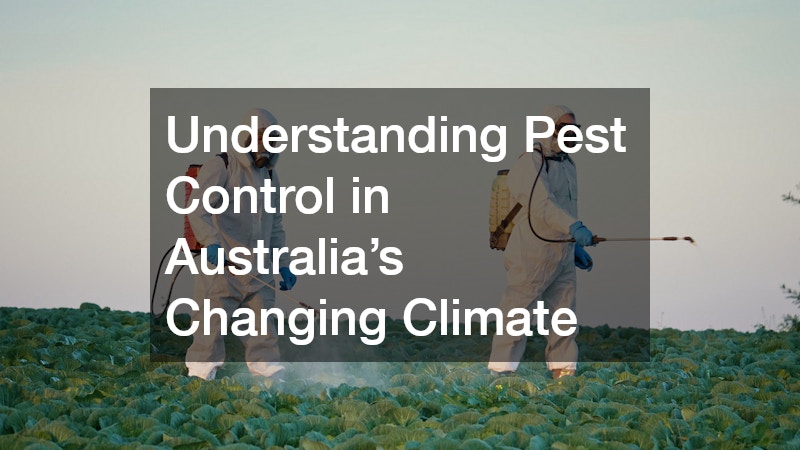As climate conditions shift across Australia, so too does the behaviour of pests. For households and businesses, this means dealing with infestations more often, often unexpectedly.
To protect homes, health and property, Australians must understand how climate trends influence the need for pest control. From recognising early signs of invasion to implementing adaptive strategies, being informed is the first step in managing these unwelcome guests.
Climate Change & the Rise of Pest Activity
Australia has always dealt with a wide variety of insects and rodents, but recent environmental changes have accelerated their spread. Milder weather allows pests like cockroaches, ants and mosquitoes to survive longer and reproduce more frequently. Increased rainfall in some regions contributes to higher humidity levels, creating ideal breeding conditions for termites, fleas and flies.
Additionally, droughts and bushfires are forcing animals and insects to migrate. As their natural habitats are destroyed or dry out, they often move into residential and commercial areas in search of food and shelter.
Urban centres are seeing higher incidences of pest sightings, with species like the redback spider, European wasp and even bed bugs appearing in new locations. These shifts call for regular inspections and a greater awareness of early infestation signs.
Identifying Bugs Early Makes a Difference
Spotting bugs early can prevent minor issues from becoming full-scale infestations. Homeowners should keep an eye out for droppings, damaged food packaging, bite marks on furniture and unusual smells. Seeing even a single pest may indicate a larger hidden population, especially in the case of termites or cockroaches.
Windowsills, basements, kitchens and outdoor bins are common problem areas. It’s also important to inspect warm, damp spaces like under sinks, garden sheds and wall cavities. Many insects, including silverfish and spiders, favour these undisturbed zones.
Using a torch and regularly checking these areas helps identify pests before they become a costly problem. Routine vigilance, particularly after rain or during seasonal changes, is one of the most effective deterrents.
Prevention & Long-Term Control
Preventative measures are more important than ever. Sealing cracks, installing fly screens and keeping food stored in airtight containers can reduce the risk of an infestation. Draining stagnant water and trimming vegetation near buildings also helps reduce nesting sites for mosquitoes and rodents.
Where possible, natural deterrents like peppermint oil or citrus sprays can repel insects without the use of harsh chemicals. In gardens, companion planting—such as marigolds near vegetables—can reduce the presence of aphids and beetles.
For ongoing protection, consider scheduling regular property inspections with a licensed professional. Annual checks can identify subtle signs of infestation, such as mud tubes from termites or hidden nests in roof cavities. These early interventions often prevent the need for more invasive treatments later on.
Urban Expansion & Pest Habitats
Australia’s growing cities are also changing the landscape of pest habitats. Construction sites disturb soil, displacing ants and beetles into nearby homes. High-density living means pests can travel easily between units, especially in apartment blocks where shared walls and plumbing offer ideal transit routes.
As more green spaces are converted into housing or commercial zones, native insects lose their habitats. In response, some species adapt quickly to man-made environments, thriving in gutters, bins and poorly ventilated areas.
This increasing overlap between human spaces and pest ecosystems means education and cooperation are essential. Strata managers, landlords and homeowners must work together to manage pest risks across entire complexes or neighbourhoods.
Climate Trends & Evolving Treatment Methods
As pest behaviours change, treatment methods must evolve too. Traditional pesticide-heavy solutions may no longer be effective—or environmentally sustainable. In recent years, eco-friendly and low-toxicity options have gained popularity, focusing on disrupting pest lifecycles rather than blanket extermination.
Professionals are now using baiting systems, heat treatments and biological controls like introducing predatory insects to manage certain outbreaks. These techniques offer long-term solutions with minimal impact on people, pets and native wildlife.
Integrated pest management (IPM) is one such approach that combines inspection, monitoring and targeted treatments. It promotes environmental responsibility while delivering effective results, especially in sensitive areas like schools or food establishments.
The Role of Pest Management in a Changing Nation
Although individuals can take many steps to reduce pest issues, professional support remains a cornerstone of effective protection. With shifting pest behaviour due to climate change, Australian pest control services are adapting their methods and training to stay ahead.
By incorporating real-time data, weather trends and geographic factors, these services can offer tailored solutions. Whether it’s a termite barrier for a coastal home or a rodent exclusion plan for an inner-city warehouse, professional advice ensures lasting results.
Timely action and expert guidance often prevent minor issues from escalating into health risks or property damage. For this reason, pest control plays a crucial role in modern Australian living.
As Australia’s climate continues to change, so will the risks posed by pests. Increased infestations, new species introductions and shifting habitats are becoming more common. Staying informed, identifying bugs early and acting quickly can protect both homes and communities.
Whether through preventative habits or professional services, Australians must stay vigilant. A proactive approach—combined with a broader understanding of how pests respond to environmental change—is key to managing infestations before they take hold.
.




